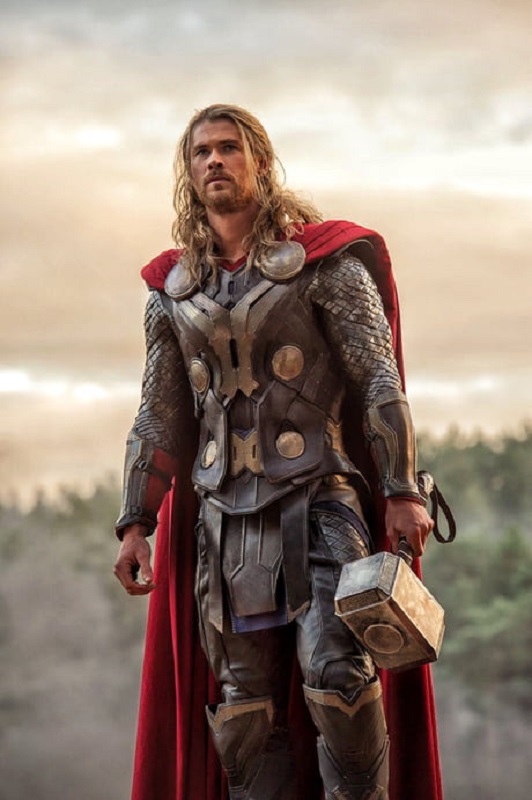

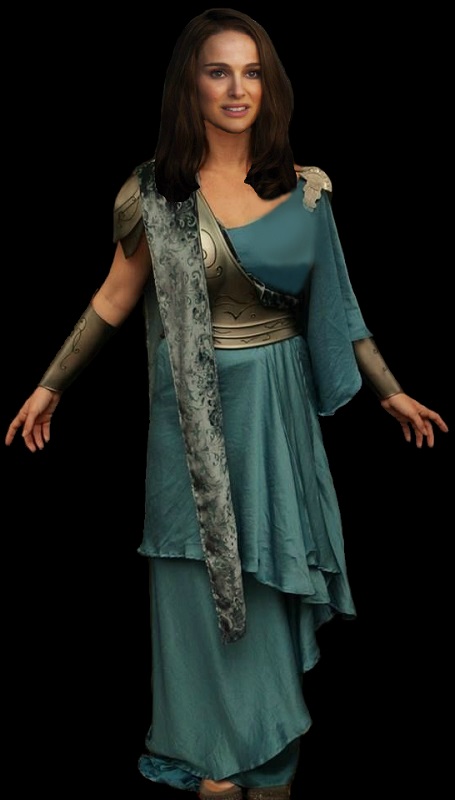


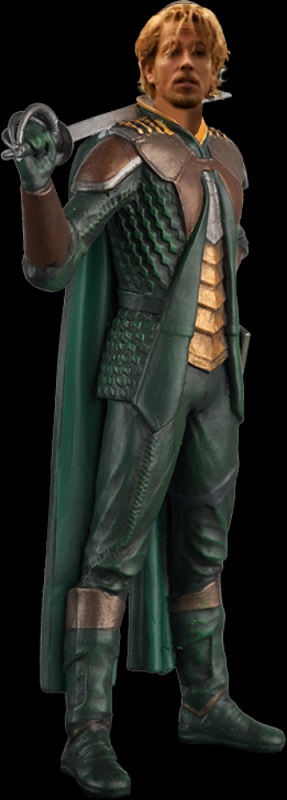






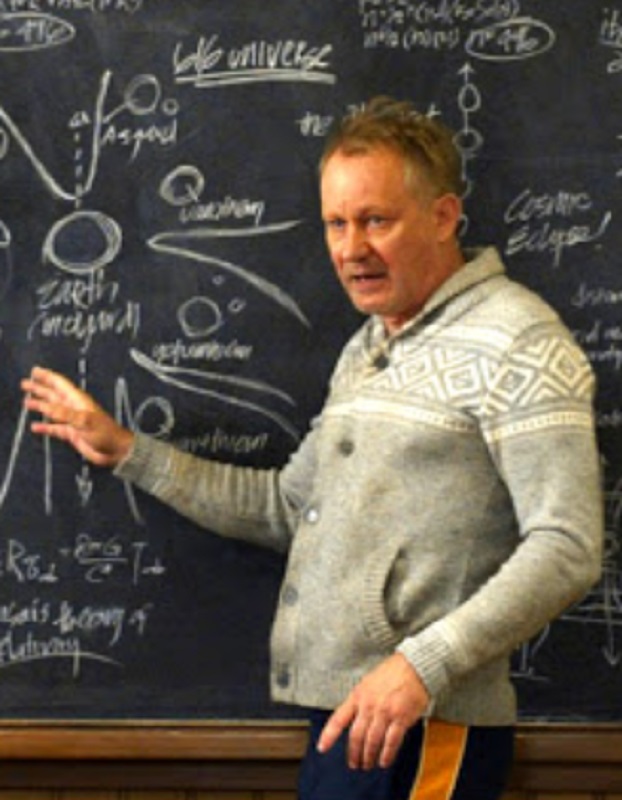
















08 – Thor: The Dark World
This movie is sometimes considered the black sheep of the early MCU films. And I’ll admit, it isn’t as good as the other Thor movies, or as good as Iron Man or Captain America. But it was still a good movie. I mean, that’s like saying The Dark World wasn’t a 10 like some of those other movies. Yeah, but it was still a solid 8, and that’s pretty good. So I did a little reading to try to figure out why people seem to regard this one as inferior to most of the other films in the franchise. And there were three things that were brought to my attention. I’ll just go over them quickly to get them out of the way.
First, the main villain, Malekith, played by Christopher Eccleston, was a pretty lack-luster, bad-guy. He was pretty cookie-cutter and unremarkable, just a warm body for Thor to beat up. He had an uninteresting back story, a bit of a dull look, and luke-warm motivations. Second, the questionable romance between Thor and Jane Foster, played by Natalie Portman, didn’t develop at all. It started in an awkward place at the beginning of the movie, and ended the same way when the credits began to roll. And finally, the main character, Thor himself, had no real sense of self-identity or purpose. He spent the movie trying to discover who he was and what he was about. This translated into how Chris Hemsworth played the character, and it showed.
But if you ask me, the good in the movie far outweighed the bad. The action sequences were top-notch. The great cast reprised the iconic rolls we remember from the first Thor movie and the Avengers, and even though the story was a little weak, it did a good job of setting them all up for their future parts in the great MCU tapestry. Sometimes you have to have a movie that is part story and part set-up, if you want to have a successful franchise. Not to mention, it did a fair job of furthering the MCU spanning story-line of the infinity stones.
My favorite part of the movie was Thor, himself, as he was supposed to be. But coming in at a close second was Loki, played by Tom Hiddleston. He was really the character with the most development in this movie, and it is part of why we have grown to love him as much as we do. He has just as much personality as Hemsworth, and he knows how to use it. Not only that, but the two actors have a great chemistry together. They may not be brothers in real life, but you wouldn’t know it when they are sharing the screen.
Then there was Jane Foster and her circle, Darcy, played by Kat Dennings, and Erik Selvig, played by Stellan Skarsgard. It was interesting what happened to Selvig’s character, in particular. Because of how his mind was really messed up by Loki in The Avengers, he went a little crazy and wound up in a mental institution. Darcy was annoying, as usual, but then again, she was supposed to be. But another supporting character who was introduced was Richard played by Chris O’Dowd, Jane’s date at the beginning of the movie. Honestly, he was charming and adorable. And we had all the Asgardians reprising their rolls… all except one. The actor playing Fandral changed from Joshua Dallas to Zachary Levi, the reason for the change being that Dallas had commitments on the TV show Once Upon a Time.
The climax of the movie was particularly thrilling as Thor and Malekith battle each other, falling back and forth between different planets. And while that is happening, Jane and her friends use their scientific equipment to transport Malekith to Svartalfheim, where he is crushed by his own ship. The battle was pretty epic, just like we have come to expect from a Marvel film. It was exciting to watch. So it wasn’t as good as The Avengers. So what? It was still good in its own right, and it did its job of furthering the Infinity Saga, and setting up the characters of Thor and Loki for what was coming in the future. Haters say this movie sucked, but they’re wrong. It was still a great watch. Like I said, it wasn’t a 10, but hey, it was still an 8!
Top 10 Favorite Parts



1938 – Spring Byington
You Can’t Take It With You
Spring Byington is one of those actresses who you don’t often think of, but who shows up everywhere in movies of all genres. Here she is in a screwball comedy, playing a rather ditsy woman, but playing her to perfection. She was not a caricature, she wasn’t over-the-top, and she wasn’t in your face. But neither was she subtle or understated. She was perfect. That’s what can happen when you have a skilled actor on the job.
Byington played the part of Penny Sycamore, mother of the film’s leading lady. She is sweet, kind-hearted, loving, slightly dotty, and altogether charming and wonderful. The kind of mom we all wish we could have. On the one hand, her head seems to be grounded in reality, though every once in a while, she’ll say something or do something that makes you question that. She, like the rest of her eccentric family, spends her time doing whatever makes her happy. She writes plays, though it is implied that she isn’t very good at it. She paints, though again, without much skill. But that is inconsequential. She enjoys her hobbies, and that’s all that matters. Sounds like a nice life to live, if you ask me.
But Byington also had to play a few scenes with some more serious emotion in them. For example, when Grandpa sells the house to Mr. Kirby, and she is being forced to move, she sheds a few tears. Or when she reads a letter from her daughter Alice, about how unhappy she is, and how she cries herself to sleep, Byington got to use her dramatic skills a little.
But I think that was the problem. As much as I liked Byington in this roll, I don’t think her performance was Oscar-worthy. But it wasn’t Spring’s fault. The roll just wasn’t that notable. There wasn’t much depth or weight to the character as it was written. Maybe if they’d kept the character’s more racy attributes from the original play, Penny might have been a more interesting supporting character. In the source material, the plays she was writing were adventure and sex-filled melodramas. And during the Kirby’s visit, she actually got them to talk about their sex lives. Now that would have been risqué for 1938!



1938 – Billie Burke
Merrily We Live
I’m starting to think that Billie Burke was a one-trick pony. I’ve only seen her in a few films, but she seems to play the exact same character every time. But darn if she doesn’t do it so well. She played the ditzy mother figure. From The Wizard of Oz to Topper, to Merrily We Live, it all seems to be variations on a theme. But that‘s just it. She wasn’t unattractive, and she was fairly adept at comedy. This was a fast-paced screwball comedy, and the dialogue was quick and witty. Burk proved that she could keep up with the best of them.
But because of the wildly silly nature of this one, she turned the scatterbrained matriarch into overdrive. She played Emily Kilbourne as a blithely vague and cheery woman who had a penchant for reforming tramps and hobos. The roll required stream of consciousness patter with a loveable disposition. You see, as a screwball comedy, I expected the entire cast to be silly in one way or another, but she seemed to lead the charge. It just seemed so natural for her.
There was only one scene in the movie where she showed a negative emotion, and that was near the beginning, when she learns that the most recent tramp has abandoned the family, stealing all the silver, among other things. She breaks into crocodile tears and flees the scene. But even that was done in a perfectly comedic way. And within the hour, when a new tramp shows up at the door, she is all smiles and sunshine once again. She was actually a delight to watch in this light-hearted film and so why not give her an Oscar nod.
But I suppose I should expect no less from her. She was a veteran actress, having started on Broadway in 1907, doing silent films from 1914 to 1921, and after several years in radio, getting into sound films in 1929. But the few roles I’ve seen her play have all been supporting roles. I’ve never seen her take the lead, though I have read that she did in some of her silent films. And apparently her final film appearance was in 1960, so she still had a long career ahead of her. But I wonder how she would have done in a serious drama. Comedians usually do incredibly well. As I’ve said before, you often have to get the comedy to deliver the drama.



1938 – Beulah Bondi
Of Human Hearts
It’s a good thing I’m judging this based on Bondi’s excellent performance, and not the ridiculous script. I’m sorry, but Abraham Lincoln, in the middle of the Civil War, had more important things do to than illegally threaten to court-marshal an army medic for being a dick to his mother, though according to legend, that actually might have happened, or something close to it.
His mother, played by Bondi, was listed as a supporting character, and I agree with that assessment. But since her relationship with her ungrateful son was really the central theme of the film, put next to the boy’s relationship with his father, I’d have understood a Best Actress nod instead. She arguably had the most screen time of the entire cast. And she embodied the central theme of the movie, which was that nobody should ever take their parents for granted, especially their mothers.
Bondi played Mary Wilkins, a woman who was used to a somewhat affluent life, but who agreed to take on a life of poverty because of her husband’s calling and work as a preacher in an impoverished rural community. But her rebellious son did not appreciate her sacrifices, and constantly asks for more and more money. And because she loves her son, she sells everything she can, becoming the poorest of the poor, to give him everything he asks for. She does so without complaint, with no thought of herself. She only wants her boy to be happy.
But when her son joins the Union Army, and fails to even write to her, casting doubt in her mind whether or not he is even alive, Beulah’s talent as a wonderful actress was really given a chance to shine. Keeping in line with the character, who was humble to a fault, she played the part in such a way as to not draw attention to herself. But the character of Mary Wilkins was written so as to keep her in the forefront of the narrative, shouldering most of the emotional drama of the film. There was a subtle gravitas about her that was unmistakable. She was a long-suffering wife and mother who didn’t seem to mind her suffering. And she handled the scene where her husband died particularly well. There’s no doubt that she was a skilled actress, and I’m glad that she was once again recognized for her work.
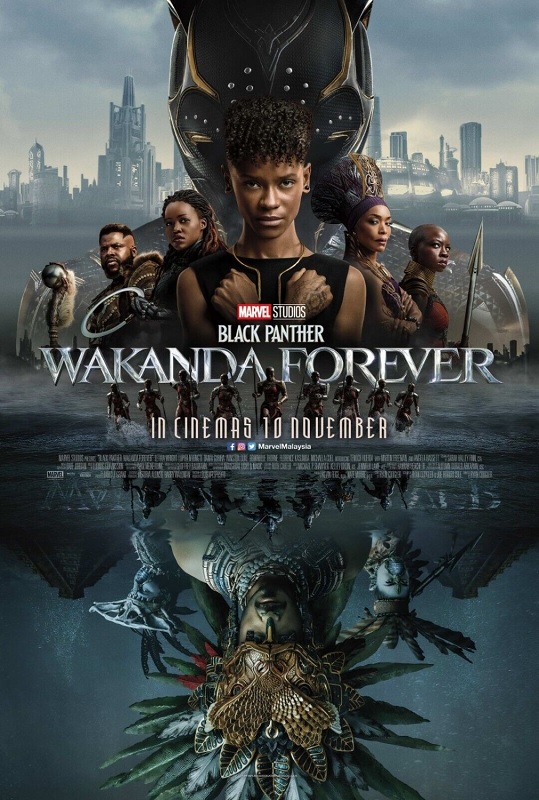
2022 – Black Panther: Wakanda Forever

The visual effects for the second movie in the Black Panther series of films were very good, but I think that maybe they could have been better. I’m sorry to say, they were up against Avatar: The Way of Water. When compared to that movie, the effects here, kind-of paled in comparison. I know, I shouldn’t be comparing the two films in a review; I should be reviewing this film’s effects on its own merits; but it is hard not to say, yeah, but look at what they could have been.
Both movies had, as part of the stories, scenes or shots that took place underwater. But Avatar wasn’t afraid to have those shots in sun-lit conditions, making the images easier to see, more detailed, more realistic, and all the more brilliant for it. Here, as happens in most underwater scenes in movies, everything was dark, indistinct, and harder to make out. I mean, I understand, light doesn’t go very deep in the ocean, but that’s what made these effects just good, rather than great.
OK, enough comparing. The other effects in Wakanda Forever that were actually awesome were those that involved Namor. We’ve seen characters fly in so many movies, but it was Namor’s method of flight that looked so cool, so unique. He had wings on his ankles. You could see them furiously flapping when he wasn’t on the ground. It was like he was standing on the clouds, running on the air, skidding to a stop to change directions, leaping from one invisible surface to another. And what’s more, it was a mode of flight that was true to the comic book source material!
So, as you might imagine, the underwater effects were good, as were the above-ground water effects. The flooding of Wakanda was thrilling to watch. The water bombs were pentahedron in shape, and looked both fantastical and futuristic at the same time. Great little design detail. We were also treated to the character of Riri Williams, wearing an Iron Man-like tech-powered suit of armor, which was pretty cool. And I also really liked the cool-looking Midnight Angel armor created for Okoye and Aneka. Great designs for all of it.
But now I have to mention something else that I didn’t particularly like. So, due to the tragic death of Chadwick Bosman, the character of Shuri, beautifully played by Letitia Wright, took on the mantle of the Black Panther. I understand that because of all the stunts, acrobatics, and action required of the superhero, it was mostly created using computer-driven CGI. But I don’t think they got the look exactly right. In more than one shot, when the CGI Black Panther appeared on the screen, it looked too thin. Yes, Shuri has a skinnier, lither shape than T’Challa, but she looked way too thin, thinner than Letitia Wright actually is. It didn’t look right, and it caught my attention in a bad way. Oh well, that’s a minor complaint. It was still fantastic, and I think the Oscar nomination was well-deserved.

2022 – The Batman

It took me a while to figure out why I wasn’t terribly impressed with the visual effects in The Batman. But I believe I now have the answer. When we go to see a superhero movie, we expect it to be a big, CGI-fueled, visual effects extravaganza. But this movie was neither an action film, nor was it filmed as a fantasy. It was a detective movie that was so grounded in reality that the superhero element, at times, seemed like nothing more than window dressing. There were no supernatural elements, no futuristic technologies, nothing that could not exist in the world in which we currently live.
But this makes sense when put under the light of director Matt Reeves’s vision. He wanted to tell a story about the early days of the Caped Crusader. He doesn’t yet have all the fancy gadgets we are used to seeing him use from his utility belt. The Batmobile can’t sprout wings or turn into a submarine. Though there was an interesting escape in which Batman’s suit turns into a wingsuit with a parachute attachment. Thus, many of the visual effects could be practical effects.
But that’s not to say the CGI effects were not used. Of course they were. But they were effects that were, in this day and age of filmmaking, pretty commonplace. There were practical explosions that were enhanced by CGI. There were sets that were extended by CGI. There was rain added to scenes using CGI. And there were digital face replacements, where the stuntmen and women’s faces were replaced with those of the lead actors. There were also a few short sequences where digital water and flood effects were created, as well as a few electricity arc effects, which were created in computers. But really that was about it. There just wasn’t much of it, and in any case, it has all been done before.
Another technology that isn’t exactly new, though I’m guessing isn’t yet the industry standard, was the use of on-set LED screens. They were used during filming as backgrounds, instead of using blue-screens, where environments and backgrounds are added in post-production. This was very effective, and has the added bonus of allowing the actors to see and be a part of the environments they are supposed to be in. I imagine this allows the actors to more readily inhabit the roles they are playing, enhancing the storytelling.
When it comes down to it, I’m not saying the visual effects were badly done. I just think they were too common, to widely used already. There seemed to be nothing new, nothing original. I did a fair bit of reading about the visual effects employed in The Batman, and I couldn’t find anything that made it stand out above any other film, let alone any modern superhero film. I’m sorry to say that while the visual effects in this film were good, it has all been done before, and done just as well.

2022 – Top Gun: Maverick

This Top Gun sequel had some pretty incredible visual effects. The Stunt flying, the incredible compositing, the design, everything, was put together to create a film that was far superior, both in the script and the visuals, than its predecessor. Of course, as you might expect most of the visual effects were all about the fast flying fighter jets, the dog-fights, and the exploding planes. Not only did they look awesome in motion, but they looked pretty cool on the ground, too.
For example, one of the effects of note in the movie was right in the opening sequence. The Darkstar, the allegedly fictional jet, which reached a speed of mach-ten. Even seeing it in the hangar, just the design of the aircraft was pretty cool. Apparently, that was a real mock-up when we see it before it takes off. But once it was in the air, it was entirely CGI. It was partly designed by real engineers that work at Leckheed Martin along with their Skunk Works Division.
And I would never have known that most of the airplanes in the film were composited. Wikipedia explains it pretty, saying, “In an interview with aviation YouTuber C. W. Lemoine, one of the VFX artists on the special effects team, Fred Lyn, stated that the use of CGI was extensive in the film with the F-14 and Su-57 visualized entirely by computer. Lyn also said that the F/A-18 scenes predominantly involved a single jet, which was then put through CGI to create the dogfight training scenes that depicted multiple jets. The four-jet strike force at the end of the film was also created through CGI from a single F/A-18.” And I would have sworn that they used four jets with four pilots.
But the effects were so much more involved than that. Of course, even though the actors were put through a boot camp so they would be able to act under extreme g-force conditions while a trained professional pilot flew their jets, the actors also had to learn to operate the camera equipment, which makes sense, since there would have been no room for a camera operator in the cockpits of actual aircraft. And all that effort was for the purpose of enhancing the realism of the visuals.
But there were also plenty of practical effects in the movie. It wasn’t all CGI. There was some pretty impressive actual stunt flying. In the third act of the film, four jets are flying through a canyon, low enough to avoid enemy radars and missiles, a tactic which put them dangerously close to the ground with mountains less than a hundred feet beyond either wingtip. If anything went wrong, the actors could so easily have died, and again, I call that impressive. And of course, Tom Cruise, the main character took on most of the screen-time, doing most of his own stunts, and even doing some of his own flying, as he is actually a pilot capable of flying fighter jets on his own. Well done, Tom!

2022 – All Quiet on the Western Front

All Quiet on the Western Front is one of those movies that had some excellent visual effects, many of which I cannot see or identify. They were in the movie to add to the realism, nothing more. They were there to enhance the storytelling on a subliminal level. We aren’t supposed to know that we seeing a visual effect. And they did their job perfectly competently. Other than that, though, they were fairly unremarkable. The problem is that these kind of visual effects have become commonplace these days, and while I cannot deny that they were done well, I didn’t find anything about them that made them stand out to me, or raise them up above the visual effects from any other film.
You see, in my admittedly small bit of research, I couldn’t find anything that showed innovation, invention, or creativity. I was more impressed with the visual effects for the Best Picture winner, Everything, Everywhere, All at Once, and the visual effects for that movie weren’t even nominated for an Oscar. The war scenes were done perfectly well, but how often have we seen battle sequences that were just as realistic with period specific WWI explosions and gunfire. We see expert compositing, digital blood, and interesting lighting effects in nearly every other movie that’s been made for many decades. I just don’t understand how these effects, while good, were better than any other.
I read an article about the visual effects in this movie and one of the most impressive things of which the article boasted was the scene near the end of the movie where there was falling snow. Apparently, they filmed in the morning when it was actually snowing, but the weather didn’t last until the shoot was done, so the continuity was maintained by adding digital snow. See what I mean? Good, but not terribly impressive.
Another effect that the article mentioned was the scene where the insane General is ordering his soldiers to go back and fight until the armistice is in effect. The crowd of soldiers standing in front of his was made larger with computer generated visual effects. I would never have guessed it, but that is just standard fair for any movie worth its salt. Why was I supposed to be impressed by that? What am I missing?
Of course, there were more noticeable effects like the flame throwers on the battlefield, or the character of Tjaden stabbing himself in the throat with a fork, a very bloody and violent effect. But really I don’t understand, nor could I find any article or review that explains why All Quiet on the Western Front was nominated for Best Visual Effects. Now, I’m not saying that it wasn’t a powerful movie. I quite agree that it deserved its Best Picture nomination. But I don’t think I agree with its nomination in this category.



2022 – Avatar: The Way of Water

I have to say, I was thoroughly impressed with the visual effects for this movie. There were images on display, the likes of which, I have never seen in my life. In fact, nobody in the world had ever seen anything like it. True, I’d guess around two thirds of the film was CGI, which many people have a problem with, but when it is done this well, I don’t mind one bit. The motion capture and facial recognition technologies that were developed and employed were beyond amazing, and made even more so, considering that much of the film took place under water.
Speaking about underwater motion capture, Director James Cameron was quoted as saying, “”It’s never been done before and it’s very tricky because our motion capture system, like most motion capture systems, is what they call optical base, meaning that it uses markers that are photographed with hundreds of cameras. The problem with water is not the underwater part, but the interface between the air and the water, which forms a moving mirror. That moving mirror reflects all the dots and markers, and … it creates thousands of false targets, so we’ve had to figure out how to get around that problem, which we did. … It’s taken us about a year and a half now to work out how we’re going to do it.”
But something else that impressed me was the live action elements, and how they were seamlessly blended with the CGI. For example, Spider was a fully live-action character. And yet you’d never know he was acting with computer generated images, even though there were the size differences between the Na’Vi and the human child. But actor Jack Champion, who played Spider, handled it all perfectly.
And then there were the new alien environments and all the extremely detailed design elements. The aesthetics of the film were just incredible. This includes the physical differences between the forest Na’Vi and the water Na’vi; the forest plants and creatures as compared to those of the sea. The giant whale-like Tulkun looked just as incredible out of the water as in, even when they were interacting with the large, futuristic water-vessels of the humans. There was one awesome shot that comes to mind, in which a Tulkun leaps out of the water and lands on the deck of a ship. It looked every bit as real as the live-action boat it was attacking.
And speaking of the futuristic designs of the human ships, weapons, and technologies, they were perfection. Cameron actually made them look just as cool as the CGI alien elements of the film. I especially liked the U-boats with their harpoon guns. They were a terrible part of the film’s narrative, but they looked pretty awesome. The hyper-detailed design of every single part of the visuals was just stunning, and I can’t wait to see what Cameron comes up with in the next installments of the franchise, slated to come out in 2025, 2029, and 2031.